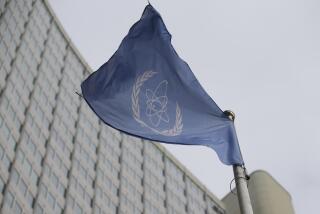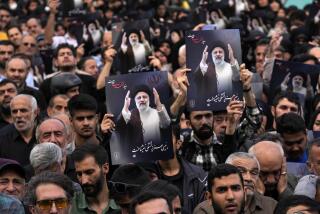‘World’s most robust’ nuclear inspection program under fire as Trump tries to rewrite the Iran deal
Reporting from Vienna — Inside two curved glass towers on the outskirts of this elegant capital, analysts pore over satellite imagery and tests of environmental samples collected from nuclear sites in Iran.
Two thousand miles away, at Iran’s main uranium enrichment complex near the city of Natanz, a small team of international inspectors studies information transmitted around the clock by surveillance cameras, online monitors and fiber-optic seals on nuclear equipment.
The International Atomic Energy Agency describes the transcontinental monitoring program it operates as the toughest and most technologically advanced inspections regime put in place to prevent a country from developing an atomic bomb.
But some Trump administration officials and outside experts argue that the organization — the United Nations’ nuclear watchdog agency — is not inspecting Iranian facilities aggressively enough. And they say that the 2015 agreement, under which Iran accepted limits on its nuclear activities in exchange for relief from crippling sanctions, has not reined in its provocative behavior elsewhere — including testing ballistic missiles, imprisoning Americans and allegedly arming Shiite Muslim rebels in Yemen.
In the coming days, President Trump will decide whether to recertify the nuclear agreement with Iran, which he has steadfastly denounced as “an embarrassment” and “the worst deal ever.”
Trump’s attacks have focused attention on a 60-year-old nuclear oversight agency, staffed largely by scientists, engineers and data analysts, that has battled to protect its neutrality while working in some of the most volatile environments in the world.
In an interview, the director general of the IAEA, Yukiya Amano, defended the agency and what he has called the “world’s most robust” nuclear inspection effort.
“We have the strongest verification regime in Iran,” Amano said in his office overlooking the Danube River. “We have experienced, well-trained inspectors and we are doing our job impartially, objectively and factually.”
In August, Trump’s U.N. ambassador, Nikki Haley, visited Vienna and urged the agency to inspect Iranian military bases that are not among the 18 declared nuclear sites to which monitors have regular access under the agreement. Although Haley said she was “impressed” with the IAEA, many read her comments as a critique of the agency’s cautious approach under Amano, a veteran Japanese diplomat.
Seven times, the IAEA has reported that Iran is meeting its obligations under the nuclear deal, which caps its stockpiles of enriched uranium and other materials in order to extend the time the country would need to manufacture a nuclear bomb.
Separately, a U.S. law requires the president to certify to Congress every 90 days that Iran is in compliance, which Trump has done twice — the last time after a contentious White House debate. Trump has threatened to declare Iran in violation of the deal by Oct. 15, when his next report is due.
If he does, Congress could decide to reimpose sanctions, likely provoking a backlash from Iran and opening a rift with allies who argue that the hard-won deal has shed light on a nuclear program that Tehran long tried to hide from the world. By decertifying Iran’s compliance, Trump would also contradict the advice of senior aides including Defense Secretary James N. Mattis, who said this week that maintaining the deal was in the United States’ national security interest.
“We have more confidence in the peaceful nature of Iran’s current activities than we did a few years ago,” said one Western official in Vienna who requested anonymity under diplomatic protocol. “How much more it is hard to say. But the level of access and the sorts of things the agency is able to measure now give you increased confidence.”
Secretary of State Rex Tillerson said Wednesday that he would be giving Trump “a couple of options of how to move forward” on the nuclear deal, but did not indicate what those would be.
Current and former IAEA officials describe an inspections regime that is far more intrusive than what existed before Iran and the so-called P5+1 — the United States, Britain, France, China and Russia, plus Germany — began implementing the agreement in January 2016.
“It provides for the strictest IAEA verification and monitoring to date anywhere,” said Tariq Rauf, who led the agency’s verification and security policy coordination office until 2011.
Iran used to bar inspectors from certain Western countries and would occasionally deny visas to IAEA personnel investigating the possible military dimensions of its nuclear program. Now Iran issues long-term, multiple-entry visas to inspectors. Diplomats briefed on the program say that six to 12 agency personnel are in Iran every day, some based at a small working space provided by authorities at Natanz.
Inspectors have daily access to Natanz and Fordow, a former enrichment site built under a mountain outside the holy city of Qom, Rauf said. Two-thirds of the more than 15,000 uranium-enriching centrifuges once installed at Natanz have been removed since the agreement. Nearly all the centrifuges at Fordow were taken offline or placed in storage, leaving about 300 to produce isotopes for medical purposes.
The remaining equipment at both sites is under constant surveillance, reducing the need for in-person inspections, officials said. An old system involving home movie cameras — modified to start and stop in order to provide months of footage — has been replaced by high-speed color cameras with fisheye lenses that the IAEA says has helped produce a 90% increase in images.
The agency has installed an online monitor that instantly measures uranium enrichment in gas flowing out of the centrifuges at Natanz, a process that used to take upward of three weeks because samples had to be shipped to Austria for analysis.
“The actual work of the inspectors has evolved significantly,” said Thomas E. Shea, a former agency official. “Iran actually doesn’t have that many sites to be monitored. It’s a very politically sensitive program but not so technically challenging.”
But inspectors still face restrictions. Worried about the possibility of espionage, Iran does not allow surveillance data to be transmitted directly back to IAEA headquarters. Iran still blocks American inspectors, although some U.S. personnel work in Vienna as part of the agency’s beefed-up Iran Task Force of about 80 inspectors and analysts.
With an annual budget of $425 million — less than half that of the Los Angeles Police Department — and no in-house intelligence-gathering capability, the agency relies heavily on information from member states. The satellite images projected onto walls at its headquarters are usually purchased from commercial sources.
Iran says it supplies the IAEA with more access than any other country.
“There is 24-hour surveillance, and we don’t have more than 24 hours in a day,” said Seyed Hossein Mousavian, a former Iranian nuclear negotiator, now a scholar at Princeton University. “If the IAEA needs something more, they would raise it with Iran.”
But the agency’s critics say it could still be much more assertive, particularly regarding Iranian military sites, which have emerged as the most controversial element of the nuclear deal.
The agency can request access to any Iranian facility if it has evidence of nuclear activities occurring there, Western diplomats say, but inspectors have not used that authority to attempt to investigate military areas since the deal was implemented.
Critics say that is a serious oversight because Iran is believed to have tested nuclear explosives at the Parchin military complex southeast of Tehran more than a decade ago, then blocked the IAEA from the site for three years while it bulldozed structures and paved over a large area with asphalt.
Despite the renovations, inspectors found traces of manmade uranium there in 2015, consistent with nuclear-related work that Iran was required to disclose.
Two outspoken opponents of the Iran deal — former IAEA Deputy Director Olli Heinonen and David Albright, president of the Institute for Science and International Security — wrote recently that the agency’s “lack of ongoing access to Parchin calls into question the adequacy of the verification of the [nuclear deal] and the deal’s long-term utility to deter Iran from obtaining nuclear weapons.”
Amano said the agency does not distinguish between civilian and military sites, and that “when we identify the need, we seek access to the location.” Under a provision known as complementary access, IAEA officials said they had conducted 25 short-notice inspections of nuclear and other sites in Iran in 2016, the most of any country.
But diplomats said nearly all the inspections were of less sensitive facilities such as universities and manufacturing plants. They said the agency was being careful not to provoke a confrontation by demanding access without evidence to sites that Iranian officials have said are off-limits to foreign inspectors.
A second Western official said agency leaders had told him they had no information to warrant investigating a military facility. But he added that inspectors would eventually need to visit sites such as Parchin before they are able to conclude that all of Iran’s nuclear material is being used for peaceful purposes.
“We try to avoid micromanaging the experts,” the official said. “But one of the things we try to remind them about is that they are conducting monitoring and verification in a heavily politicized context, and they haven’t got as long as they like.”
The agency has also faced criticism for reducing the information it releases publicly about its Iran program. In his most recent quarterly report, issued Aug. 31, Amano did not specify the size of Iran’s enriched uranium stockpile, saying only that it did not exceed the 660-pound limit set by the agreement. And it said the agency was monitoring a part of the deal known as Section T, which prohibits activities that could be used to develop a nuclear explosive device, without any details.
“It’s not clear how the IAEA is confirming that, given that work would happen at a military site,” said Valerie Lincy, executive director of the Wisconsin Project on Nuclear Arms Control.
Lincy said there was nothing in the nuclear deal, a related U.N. Security Council resolution or IAEA rules that prevented Amano from releasing more detailed information. It would also be politically expedient given Iran’s history of obfuscations about its nuclear work, she added.
“We’re not talking about IAEA inspections in the Netherlands. Iran is a slightly different context,” Lincy said. “This is an extremely controversial agreement, and to the extent you can reassure people about its performance so people have confidence in its effectiveness, that’s a powerful thing if you’re a supporter of the agreement.”
Former colleagues say Amano is extremely guarded by nature and wary of being portrayed as too close to the United States, which provides 25% of the agency’s funding.
“It is not a practice that when some countries ask for more [information], I say, ‘Let’s give more,’” Amano said. “The basic rule is that safeguards-related information must be kept confidential.”
The IAEA, which monitored nuclear activities in Saddam Hussein’s Iraq and in North Korea until inspectors were expelled in 2009, is used to being at the center of diplomatic disputes. But Amano maintains that it is a technical organization that happens to work in politically charged situations.
“Generally, it manages to stay above the fray in an exemplary fashion,” said Peter Jenkins, a former British ambassador to the agency. “I do have a great deal of confidence in their integrity.”
Follow @SBengali on Twitter
ALSO
Pentagon chief says keeping Iran nuclear deal is in U.S. security interest
Trump’s national security aides voice support for the Iran nuclear deal
Tillerson denies reports he plans to resign and pledges support for Trump
More to Read
Sign up for Essential California
The most important California stories and recommendations in your inbox every morning.
You may occasionally receive promotional content from the Los Angeles Times.











